ST BRIGID'S CATHOLIC PRIMARY SCHOOL HISTORY
Nestled in rich farming soil of the Gold Coast Hinterland on the banks of the Nerang River and land of the Kombumerri / Yugambeh people, the site for the proposed Catholic Primary School was purchased in 1991. Building began in 1993 and the first stage included an administration building, six classrooms and a church. The Pre-school was the first Catholic Pre-School on the Gold Coast. St Brigid's Primary School Nerang, 39-49 McLaren Road, opened its doors on February 1, 1994 and welcomed 128 students from Pre-school to Year 4 with Tony O'Shea as St Brigid's Founding Principal and Father Mark Percival as St Brigid's Parish Priest.
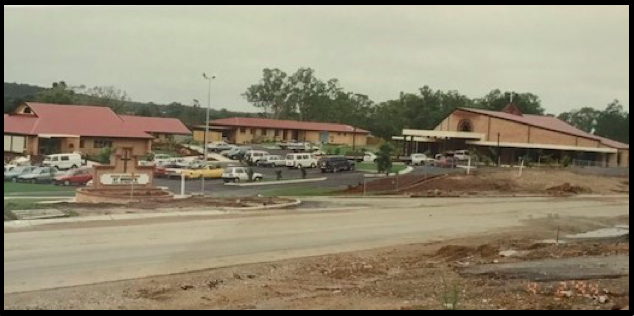

A second stage was completed in 1996, extending the school's size by four more classrooms. By the end of 1998, the new Library, covered area and Tuckshop were completed. At the end of 1999, the school had grown to “two-stream" capacity. The following 15 years saw an extension to the Preparatory Area, the building of the Eco-Enquiry Building, Tuckshop and Uniform Shop and refurbishment of the Multi-purpose Area, renovations to the Administration Building and expansion of the car park.
In 2016, the St Brigid's Vision and Mission statements were revised through a collaborative process with the School and Parish community which saw an enhanced identity evolve. Our buildings took on names which now reflect our school's Indigenous and Celtic heritage.
Just as St Brigid led by example, showing compassion and providing care and concern for those less fortunate; the new St Brigid's Way of FAITH, PEACE, LOVE, COMPASSION and RESPECT continues to embrace the school's motto 'Making Christ Present' and clearly articulates how we all live and learn at our school.
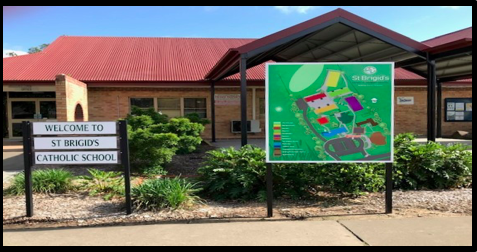
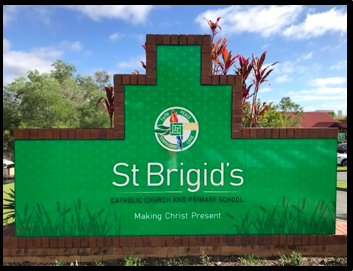
The Early Days : Establishment of St Brigid's Parish
In 1870 on November 24, Bishop Quinn sailed to London as a Saloon Passenger. He arrived on March 1, 1871. He then travelled on to Rome. Bishop Quinn was on a mission to obtain priests who were willing to travel to Queensland, Australia as missionaries.
The Brisbane Diocese was considered an outpost at this time, so the type of personnel required for the job would need to have an adventurous heart and a firm belief in the need to spread the Word of God. Bishop Quinn would have realised the need for strong men for the job. The priests required for the position would need to be physically, mentally and spiritually strong. Today, we would probably add to this list of attributes – self-motivating and resourceful in basic survival in the bush. Queensland at this time was just a young state. Catholics were in the minority throughout Australia, particularly in Queensland.
Bishop Quinn sailed out of London after coming from Italy with two young, newly ordained priests. Both men were Italian; possibly they spoke little or no English. After five months at sea, they arrived in Brisbane ready to take up their posts. Father Benedict Scortichini who was an amateur botanist was to over-see the Logan Mission. The other priest was also to take up a similar mission somewhere else within the Archdiocese. The Logan Mission would have taken in a huge area stretching from the Logan River, then inland to Beaudesert and south to the New South Wales border. It may have been his interest in botany that first swayed Father Benedict to take up the offer to come to Australia. Australia would have been seen as a land of strange plants to a young botanist from Italy.
Horseback was the mode of transport and the river or creek meanderings would have been the best and surest way to find one's way about the bush where roads were almost non-existent. Farms were being settled throughout the Logan Mission area. As soon as the timber was cut and made ready to transport, it was then hauled out by bullock trains to the river routes for transporting to the sawmills. Sawmills started appearing wherever a viable business scheme was deemed possible. Men in the business would have known the potential of the area with its natural tall trees waiting to be harvested. Setting up a business then would have been just the same as setting up a business today, except that transport was a major factor. One of the main ports for goods going in and out was the Nerang River. The Nerang Creek, as it was then known, linked Nerang to Southport, and then directly to Brisbane. Wherever the mills were, the workers gathered and set up dwellings, some less permanent than others. Some housed single men but many of the timber getters, mill workers and mill owners were family men. So, it was within these communities that Father Scortichini tendered his flock.
Apparently, there was also a very hard-working minister of the Anglican denomination who tended his flock in more or less the same geographical area. It is believed that they moved about, doing their rounds on horseback, serving their communities, but rarely did their paths cross. However, when a minister of religion was vitally required, one or the other was usually there to serve.
Because Nerang made an excellent port, with its flat area and proximity to the surrounding timber and sugarcane, and later the dairy farming industry that developed, it became a major centre. Surrounding government schools were awarded a holiday to attend the Nerang Show. It must have been a great event. It would have been a time to gather and show produce, livestock and handy work; probably sewing, cooking and sideshow alley as well. Nerang was also an important mail stop with Cobb & Co. having a depot for mail and passengers.
The first Mass in a public building in Nerang was in the Dining Room at John Shay's Star Hotel. The Directory for Parishes shows that St Brigid's Parish at Nerang was set up in 1883, only a couple of years after Father Benedict took on the mission of Logan. There is also indication that another church near Beenleigh called Saint Bridget's was registered in 1887 in the Logan Mission, or Logan Reserve as is shown in some records. It was suggested that the John Shay family may have had some say in the naming of the church because of their staunch support and assistance to Father Benedict. The name “Shay" is Irish, so perhaps they chose a familiar saint's name. Saint Brigid is, of course, an Irish Saint. Efforts to link “Saint Brigid" with “Saint Bridget" lead nowhere. However, spelling back then was a hit and miss arrangement. The settlement of Mudgeeraba was spelt three different ways before it became uniformly spelt the way it is today.
Father Benedict Scortechini returned to Italy in 1885 or 1886 and never returned to Australia. He died there at forty-five years of age.
Between 1874 to 1880, A church at Tallebudgera was established and named “All Saints". Tallebudgera was first an important timber area and then a thriving dairy farming community. Southport had a church built before it was recognised as a parish. Later, the Saint Vincent de Paul Order of priests took on the management of the Southport parish, which must have incorporated the whole northern part of the now South Coast Deanery, from Beenleigh, Oxenford, Runaway Bay and the northern side of the Nerang River.
In 1956 Burleigh was declared a parish and began with twenty thousand parishioners. St Brigid's Catholic Church in Nerang seemed not to have had a Parish Priest until Father Pat Tynan arrived in the early 1980's. Before his arrival, priests would travel from Southport or other places to serve the people of Nerang. Father Pat Tynan was partly responsible for the building of the old White Street Church which housed the community of Catholics in Nerang for ten years. After ten years the community was growing so fast and so large that the decision was made to expand. The choice seems to have been between either spending around thirty thousand dollars to upgrade the current building or to branch out into new premises and construct a new Church plus a primary school and high school, although the plan for a high school did not go ahead. On January 9, 1983 St Brigid's became a parish in its own right with Father Tynan as the first Parish Priest and a Presbytery and Church were built at White St, Nerang.
Purchase of the Land for St Brigid's Catholic Primary School
As far back as 1989 our nearest Catholic Primary Schools – Guardian Angels, St Kevin's and St Vincent's had no alternative but to persuade Nerang to provide an additional school to service the Hinterland. Fr Pat Tynan encouraged Gerry Byrnes (a Parishioner at the time and teacher at Aquinas College) and a small number of interested people to evaluate the situation. A survey they undertook through the existing schools and our own church revealed 154 families who would be prepared to use the school.
The Committee then proceeded to locate a suitable block of land for the purpose of building a new school and relocating our church, the latter being the only means by which we could conceivably carry through the project financially i.e. selling the White Street property, where the existing church only, was located.
The Brisbane Archdiocesan and Catholic Education Offices were supportive of these endeavours and numerous properties were inspected and appraised. No one though expected it would take almost three years before we finally located our McLaren Road site. The committee of the time is to be congratulated for their perseverance! In fact, McLaren Road had been considered at an earlier stage, however existing Albert Shire regulations at the time and the buoyant market process meant it did not meet requirements. Over the next two years though, both situations altered in our favour and when the property was listed for sale again, we unexpectedly found ourselves there. It really was the Lord's perfect timing.
November 27, 1991 a Contract was signed pending successful rezoning. On June 12, 1992 the parish took possession. On October 23, 1992 we blessed our land, Fr Mark Percival having arrived on February 24, 1992, to carry on from Father Pat. The parish had decided the only feasible way to establish a school was to sell White Street and relocate all services at the larger McLaren Road site and to do it in one movement. On July 17, 1993 we had our soil turning ceremony marking the commencement of building.
During this time, several companies were examined and interviewed which resulted in G & M Consultants Pty Ltd being engaged as our Project Managers and Cordukes Pty Ltd as the builders and so building began in 1993.
St Brigid's Catholic Primary School Principals
Tony O'Shea Foundation Principal 1993-1997

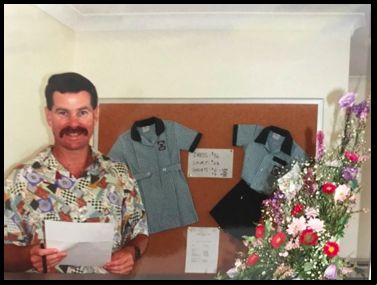
Tony O'Shea was the Foundation Principal of St Brigid's Catholic Primary School Nerang from 1993 to 1997.
Mr O'Shea was appointed as Principal in 1993. He worked closely with the Parish Priest, Father Mark Percival to establish the school and its community.
Mr O'Shea and the school's Parents' and Friend's Association had many meetings before the school opened. These discussions involved many topics including uniforms and the school emblem. The school motto “Making Christ Present" has always been part of the school culture.
The Foundation School Staff
Father Mark Percival
Mr Tony O'Shea
Mr David Cashman
Mrs Fiona Ogge
Ms Ardena Lillana
Miss Shandel Smith
Mrs Ronnie Wilson
Mrs Desley Pendergast
Mrs Marianne Franks
Ms Tania Le Couilliard
Mrs June Boulton
Mrs Lyn Bray
Mrs Clare Parker
Mrs Liz Gray
Mrs Gail Gill
Our Parish included the Good Shepherd sisters, Sister Angela and Sister Christine. These ladies were a driving force in the parish from approximately 1985. They were part of the parish for 15 years. The Sisters worked tirelessly to build and maintain a strong St Brigid's Community, and organised many events which included fetes, retreats, social events, family dinners, as well as running the Sacramental Programs for the Nerang Parish. When the school began, they moved onto the site and lived in the parish centre. The school's strong community was built on the work done by these sisters.
On February 1, 1994 St. Brigid's Catholic Primary School opened its doors to 128 excited children from Preschool to Year Four. Mr Tony O'Shea commented, “that he was honoured to be the foundation principal at St Brigid's". The buildings that were completed at this stage were the Administration Block, Block A, classrooms, the Tuckshop and the Preschool Classroom along with the church.
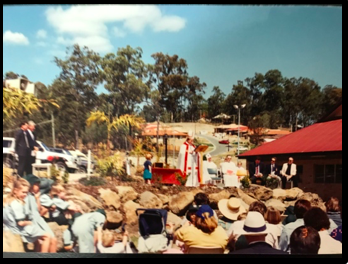
Mr O'Shea assisted in both the celebration of the Dedication of St Brigid's Church on Sunday February 6, 1994 by Archbishop John Bathersby and September 3, 1994, when the first time capsule was buried.
September 6, 1994, was the Blessing and official opening of St Brigid's Catholic Primary School by Archbishop John Bathersby.
As the school expanded, Block B and the school library were constructed, along with renovations of the administration area. This led to the library moving to a classroom in Block B.
Once the school opened, The Parish Fete was expanded to include the school. It was a large and exciting event, with parish and school meeting and working together.
Our character book parade also started during this time. Mrs Jan Knowles, our teacher librarian instigated the book parade and for more than twenty years kept the excitement alive. It is still an annual event.
Under Tony's leadership, the students enjoyed our inaugural sport's carnival, where students were always encouraged to do their personal best.
A walkathon was also held in the surrounding area. Armed with maps, students explored the local streets as they walked. All students found their way back to school!
From when the school opened, there has always been an Outside School Hours Care Service It was initially set up in the parish centre.
Greg Benfield Principal 1998-2003

Greg Benfield joined St Brigid's staff as the 2nd Principal leading 27 staff members, Preschool to Year 7.
Mr Benfield continued with the construction of the buildings. The under cover area, tuckshop and Block C comprising of classrooms and Outside School Care building was completed alongside the library. The official Blessing and Opening of these buildings by Rev. Father Kevin Carey and Rev. Father Mark Percival occurred on Friday, July 23, 1999.
During Mr Benfield's time, he placed air-conditioning in all areas of the school. Also during this time, the staff put on two plays for the students and parents and the first Under Eight's Day was celebrated which involved the whole school community. The first one included pony and tractor rides. This event has become an annual event that we all look forward to. Sister Brigid Frawley joined our staff as a Pastoral Care Support person to both children and staff. She was a very valued part of our community until 2017. The little students often got confused and called her “Saint Brigid."
Annette Duffy Principal 2004-2010
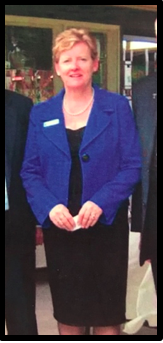

Annette Duffy came from Guardian Angel's Catholic Primary School, Ashmore, to join St Brigid's staff as principal in 2004 and was very proactive in developing community engagement.
In 2006, the Preschool rooms were updated to accommodate the Preparatory year. An Eco-Inquiry Centre, housing an art, science and music room was commenced. The undercover area's conversion to a hall was also begun. These buildings were opened and blessed on Friday 9 November, 2012.
Mrs Duffy bought the community together by raising awareness of young girls in Tanzania. She headed the St Brigid's charity to support the Tanzanian non-government organisation. $10,000 was raised within the school towards building a dormitory for the Maasai girls.
Her other passion was to improve and promote indigenous education, reconciliation and cultural learning for both indigenous and non- indigenous students and families.
Mrs Duffy organised indigenous women to paint murals around the school to educate the St Brigid's students, staff and families about indigenous symbols.
The St Brigid's School Board was established under Mrs Duffy's direction.
During this time, Maryanne Sandstrom began teaching music and has continued to foster music and The Arts, both in class and individual lessons.
Tony O'Shea Principal 2010
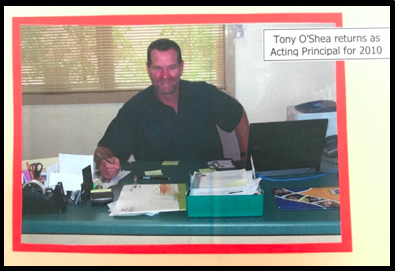

Mr O'Shea returned to St Brigid's as Acting Principal for most of 2010.
He supervised the existing building projects including the Eco- Inquiry Centre and the Multi-purpose Hall.
Mr O'Shea often said he enjoyed coming back to see how the school was developing.
Kevin Bianchi Principal 2011-2016
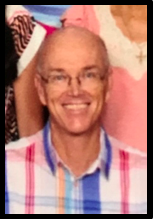

Kevin Bianchi came from St Joseph's Catholic Primary School, North Ipswich and joined the St Brigid's staff in 2011. The Parish Priest at this time was Father Rafal Rucinski.
Mr Bianchi finalised the existing building projects including the Eco- Inquiry building, the Multi-purpose building and the refurbishment and extension of the Administration building and Staffroom. The office staff had to temporarily relocate for the work to continue. These buildings were opened and blessed on Friday November 9, 2012.
Mr Bianchi introduced “Robo", the school's behaviour program mascot which has now been replaced by the Positive Behaviour for Learning Behaviour Support Framework.
· Respect for self and others
· Respect for Learning
· Respect for property
Mr Bianchi was a great advocate for music education and introduced the St. Brigid's Music Program including a school band. He instigated the opportunity for every Year Three student to experience a musical instrument.
A Sun Safety Policy was also introduced under Mr Bianchi.
Mr Bianchi was responsible for developing and renewing many of our school policies.
Active School Travel was promoted by Mr Bianchi and embraced by the whole school community.
David Sewell Principal 2017-2020


David Sewell, who came from Jubilee Primary School Pacific Pines, commenced at St Brigid's in 2017. During his time, Mr Sewell revised the school's Vision and Mission. This process of collaboration with the whole school and Parish community, saw an enhanced identity evolve.
Mr Sewell oversaw the modernisation of the Eco- Enquiry building, upgrading of the Prep buildings and grounds. It was as a result of this process that the buildings took on names which reflect Indigenous and Celtic heritage.
· BUJERIM - BLOCK A
· GUNGANGAN - BLOCK B
· KARULBO - BLOCK C
· GUMERA - PREP
· NYEUMBA - ADMIN BUILDING
· NGIRIGOMINEALA - MULTIPURPOSE AREA (MPA)
· GAWARIMA - LIBRARY
· KILDARE CENTRE- ECO ENQUIRY BUILDING
· THE CURRAGH - THE OVAL
Just as Saint Brigid led by example, showing compassion and providing care and concern for those less fortunate, the new St Brigid's Way of FAITH, PEACE, LOVE, COMPASSION and RESPECT continues to embrace the school's motto “Making Christ Present".
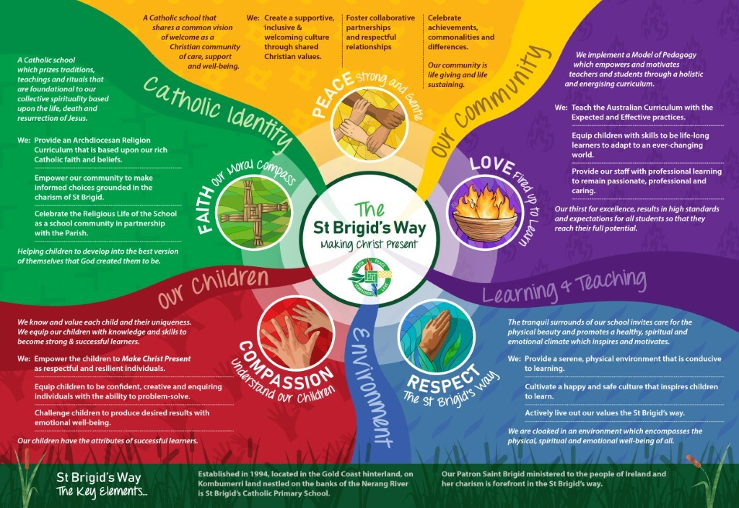
Our sports teams were also re-established to reflect the St Brigid's Way, based on Celtic language.
· AN LASAIR (The flame)
· ABHAINN (The Water)
· GIOLCACHA (The Reeds)
· SNAIDHM (The knot)
June 2019
Original staff, parents and past students were invited to attend the St Brigid's original time capsule opening with Mr Sewell which celebrated 25 years since the first school capsule was buried. A day of celebrations which inculced a whole school Mass marked the 25 years of our school's opening.
October 29, 2020
Mr David Sewell alongside Bishop Ken Howell, St Brigid's Parish Priest, Father Isidore Enyinnaya, Assistant Principal Religious Education, Belinda Kingston, Assistant Principal Administration, Julie Rey looked on by St Brigid's Staff and students through our BCE online 'Teams' platform, buried the second time capsule, to be opened in 2044.
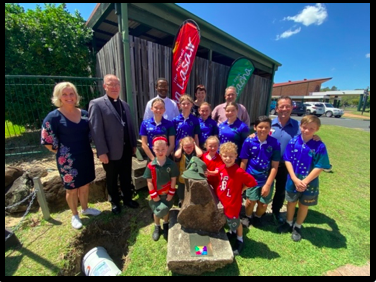
Matthew Vine Principal 2021 -
Matthew Vine, who came from St Patrick's Primary School Nanango, commenced at St Brigid's in 2021.
© Brisbane Catholic Education, St Brigid’s Catholic Primary School (2023)